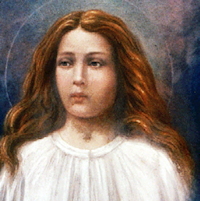Ordinary Time: July 6th
Optional Memorial of St. Maria Goretti, Virgin and Martyr
Other Commemorations: Bl. Maria Theresa Ledochowska, Virgin (RM); St. Palladius, Bishop (RM)
» Enjoy our Liturgical Seasons series of e-books!
St. Maria Goretti was born near Ancona (Italy). The daughter of a poor peasant family, Maria was well known to her neighbors for her cheerfulness and piety. When she was twelve she was a victim of assault. She preferred to die rather than to lose her virginity. She died in 1902, and her mother was present at her canonization in 1950, the first time a parent was present for a child's canonization.
St. Maria Goretti
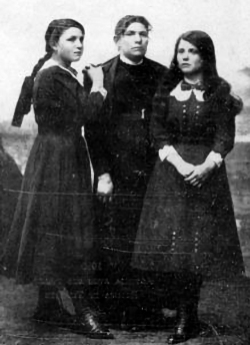 St. Maria Goretti was born of a poor family in Corinaldi, Italy, in 1890. Near Nettuno she spent a difficult childhood assisting her mother in domestic duties. She was of a pious nature and often at prayer. In 1902 she was stabbed to death, preferring to die rather than be raped. (Office of Readings)
St. Maria Goretti was born of a poor family in Corinaldi, Italy, in 1890. Near Nettuno she spent a difficult childhood assisting her mother in domestic duties. She was of a pious nature and often at prayer. In 1902 she was stabbed to death, preferring to die rather than be raped. (Office of Readings)
"It is well known how this young girl had to face a bitter struggle with no way to defend herself. Without warning a vicious stranger (actually Alessandro Serenelli who lived with his father in the same house as the Goretti's.) burst upon her, bent on raping her and destroying her childlike purity. In that moment of crisis she could have spoken to her Redeemer in the words of that classic, The Imitation of Christ: "Though tested and plagued by a host of misfortunes, I have no fear so long as your grace is with me. It is my strength, stronger than any adversary; it helps me and gives me guidance." With splendid courage she surrendered herself to God and his grace and so gave her life to protect her virginity.
"The life of this simple girl—I shall concern myself only with highlights—we can see as worthy of heaven. Even today people can look upon it with admiration and respect. Parents can learn from her story how to raise their God-given children in virtue, courage and holiness; they can learn to train them in the Catholic faith so that, when put to the test, God's grace will support them and they will come through undefeated, unscathed and untarnished.
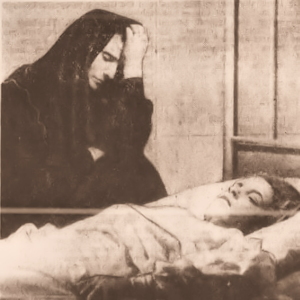 "From Maria's story carefree children and young people with their zest for life can learn not to be led astray by attractive pleasures which are not only ephemeral and empty but also sinful. Instead they can fix their sights on achieving Christian moral perfection, however difficult and hazardous that course may prove. With determination and God's help all of us can attain that goal by persistent effort and prayer.
"From Maria's story carefree children and young people with their zest for life can learn not to be led astray by attractive pleasures which are not only ephemeral and empty but also sinful. Instead they can fix their sights on achieving Christian moral perfection, however difficult and hazardous that course may prove. With determination and God's help all of us can attain that goal by persistent effort and prayer.
"Not all of us are expected to die a martyr's death, but we are all called to the pursuit of Christian virtue. This demands strength of character though it may not match that of this innocent girl. Still, a constant, persistent and relentless effort is asked of us right up to the moment of our death. This may be conceived as a slow steady martyrdom which Christ urged upon us when he said: The kingdom of heaven is set upon and laid waste by violent forces.
"So let us all, with God's grace, strive to reach the goal that the example of the virgin martyr, Saint Maria Goretti, sets before us. Through her prayers to the Redeemer may all of us, each in his own way, joyfully try to follow the inspiring example of Maria Goretti who now enjoys eternal happiness in heaven."
—Excerpted from a homily at the canonization of Saint Maria Goretti by Pope Pius XII
Maria appeared to her murderer in his prison cell to forgive him, and he was subsequently converted. He sat next to her mother at the beatification, who also forgave him.
Patronage: Against poverty; against the death of parents; children; children of Mary; girls; loss of parents; martyrs; poor people; rape victims; young people in general; Children of Mary; diocese of Albano, Italy; Albano Laziale, Italy (proclaimed on 5 May 1952 by Pope Pius XII); Latina, Italy
Highlights and Things to Do:
- Please visit this The Pilgrimage of Mercy: Tour of St. Maria Goretti's Major Relics for more information on St. Maria, in particular this article for a more detailed account of St. Maria Goretti's life and Alessandro Serenelli's conversion.
- Find out more about St. Maria Goretti:
- This young saint's feast day is a wonderful launching point to teach our children about purity, chastity and modesty. Sex education should be taught by the parents with a Catholic approach. Young girls can use St. Maria as a model.
- A highly recommended book is St. Maria Goretti: In Garments All Red by Rev. Godfrey Poage. Young teens to adult will enjoy this account of her life.
- St. Maria's relics are mainly located in the Basilica of Santa Maria delle Grazie e Santa Maria Goretti in Nettuno, Italy.
- Watch this Vatican film about St. Maria Goretti.
- See Catholic Cuisine for food ideas.
St. Palladius
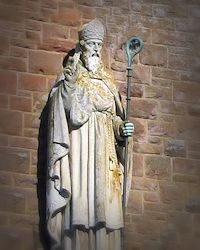 The first Christian mission to Ireland, for which we have definite and reliable data, was that of St. Palladius. St. Prosper, who held a high position in the Roman Church, published a chronicle in the year 433, in which we find the following register: "Palladius was consecrated by Pope Celestine, and sent as the first Bishop to the Irish believing in Christ." This mission was unsuccessful. Palladius was repulsed by the inhabitants of Wicklow, where he landed. He then sailed northward, and was at last driven by stress of weather towards the Orkneys, finding harbour, eventually, on the shores of Kincardineshire. Several ancient tracts give the details of his mission, its failure, and his subsequent career. The first of those authorities is the Life of St. Patrick in the Book of Armagh; and in this it is stated that he died in the "land of the Britons." The second Life of St. Patrick, in Colgan's collection, has changed Britons into "Picts." In the "Annotations of Tierchan," also preserved in the Book of Armagh, it is said that Palladius was also called Patricius, and that he suffered martyrdom among the Scots, " as ancient saints relate."
The first Christian mission to Ireland, for which we have definite and reliable data, was that of St. Palladius. St. Prosper, who held a high position in the Roman Church, published a chronicle in the year 433, in which we find the following register: "Palladius was consecrated by Pope Celestine, and sent as the first Bishop to the Irish believing in Christ." This mission was unsuccessful. Palladius was repulsed by the inhabitants of Wicklow, where he landed. He then sailed northward, and was at last driven by stress of weather towards the Orkneys, finding harbour, eventually, on the shores of Kincardineshire. Several ancient tracts give the details of his mission, its failure, and his subsequent career. The first of those authorities is the Life of St. Patrick in the Book of Armagh; and in this it is stated that he died in the "land of the Britons." The second Life of St. Patrick, in Colgan's collection, has changed Britons into "Picts." In the "Annotations of Tierchan," also preserved in the Book of Armagh, it is said that Palladius was also called Patricius, and that he suffered martyrdom among the Scots, " as ancient saints relate."
Prosper also informs us, that Palladius was a deacon of the Roman Church, and that he received a commission from the Holy See to send Germanus, Bishop of Auxerre, to root out heresy, and convert the Britons to the Catholic faith. Thus we find the Church, even in the earliest ages, occupied in her twofold mission, of converting the heathen, and preserving the faithful from error. St. Innocent I., writing to Decentius, in the year 402, refers thus to this important fact: "Is it not known to all that the things which have been delivered to the Roman Church by Peter, the Prince of the Apostles, and preserved ever since, should be observed by all; and that nothing is to be introduced devoid of authority, or borrowed elsewhere? Especially, as it is manifest that no one has founded churches for all Italy, the Gauls, Spain, Africa, and the interjacent islands, except such as were appointed priests by the venerable Peter and his successors."
Palladius was accompanied by four companions: Sylvester and Solinus, who remained after him in Ireland; and Augustinus and Benedictus, who followed him to Britain, but returned to their own country after his death. The Vita Secunda mentions that he brought relics of the blessed Peter and Paul, and other saints, to Ireland, as well as copies of the Old and New Testament, all of which were given to him by Pope Celestine.
—Excerpted from An Illustrated History of Ireland by Margaret Anne Cusack
Patronage: Scotland
Highlights and Things to Do:
- Read more about St. Palladius:
- Read the Mission of St. Palladius at Library Ireland.
Bl. Maria Theresa Ledochowska SSPC
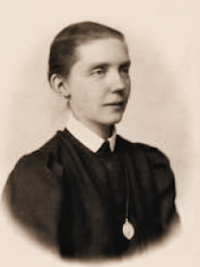 The eldest of seven children, Mary Theresa Ledochowska was born in Austria on April 29, 1863, to a Polish noble, Count Anthony, and his wife, Josephine. From her parents Maria Theresa inherited not only their noble blood, but also a heart sensitive for the needy.
The eldest of seven children, Mary Theresa Ledochowska was born in Austria on April 29, 1863, to a Polish noble, Count Anthony, and his wife, Josephine. From her parents Maria Theresa inherited not only their noble blood, but also a heart sensitive for the needy.
Even though she grew up in a very religious family, Mary Theresa did not hear much about the missions in her youth.
In 1885 Mary Theresa became a lady-in-waiting to the Grand Duchess Alice of Tuscany. In the midst of the glamour of court life, she was exposed for the first time to the needs of the missionary world.
Two Franciscan Missionaries of Mary came to Salzburg to seek financial help for their missionary work. The lady-in-waiting listened raptly as the two women religious shared their experiences of working with the lepers in Madagascar.
“I don’t know of anything more beautiful than to co-operate with God in the salvation of souls.”
~Bl. Mary Theresa Ledochowska
This spark of interest in missions was fueled to a full flame when Mary Theresa read a pamphlet on Cardinal Lavigerie’s anti-slavery campaign. The prelate of Africa called for the women of Europe to support his crusade against slavery. His call bore fruit in Mary Theresa, who would one day say, “I myself would not be here before you today, and I would probably still be a lady-in-waiting at a court in Austria, if by chance I had not seen a pamphlet by Cardinal Lavigerie, which gave me the incentive to devote myself to the missions.”
As Mary Theresa’s involvement with the missions grew, she began a mission page in a Catholic periodical. These mission features, called Echo From Africa, were based on correspondence from African missionaries. The page of letters evolved into a monthly magazine, which made its debut in 1889, even though the nineteenth century was not ready for a woman publisher.
“It is a grace to understand the essence of the missionary ideal and to work for it.”
~Bl. Mary Theresa Ledochowska
The magazine soon became a full-time job, and Emperor Franz Joseph personally released Mary Theresa from her court duties in 1891 so that she could devote all of her time and energy to the missions. Soon the work of promoting and supporting the needs of missionaries in Africa could no longer be considered one’s woman effort.
Mary Theresa, led by the Holy Spirit, enlisted “auxiliary missionaries” and placed her work under the patronage of the Spanish Jesuit missionary, St. Peter Claver, whose life ministry earned him the title of Apostle to the Slaves.
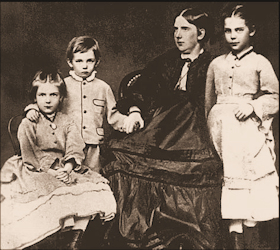 Mary Theresa’s vision took shape gradually, emerging in wonderful form. First, on April 29, 1894, Pope Leo XVIII formally blessed Mary Theresa’s enterprise, deeming the St. Peter Claver Sodality a pious association, which gradually developed into a religious community. On September 8, 1897, Mary Theresa and her first companion professed their final vows as Missionary Sisters of St. Peter Claver.
Mary Theresa’s vision took shape gradually, emerging in wonderful form. First, on April 29, 1894, Pope Leo XVIII formally blessed Mary Theresa’s enterprise, deeming the St. Peter Claver Sodality a pious association, which gradually developed into a religious community. On September 8, 1897, Mary Theresa and her first companion professed their final vows as Missionary Sisters of St. Peter Claver.
For the next twenty-five years, the Foundress roamed Europe, enlisting people of all walks of life to help her congregation’s support for evangelization in Africa. Realizing that the missionaries were in urgent need of books in local languages, she expanded her work, producing everything from Bibles and hymnals to dictionaries in local languages.
Pope St. Pius X gave his final approval to the constitutions in 1910. The lady-in-waiting’s dream blossomed into an international mission aid network. Her reward came when the recipients of her generous support offered gratitude for the assistance, calling Mary Theresa “Mother of the Africans.”
The grueling schedule of appearances and editing took its toll on Mary Theresa. Despite suffering from tuberculosis, she worked to the very end, passing away on July 6, 1922. The thousands of missionaries she had supported through prayers, encouragement, and material help felt as though they had lost a mother.
Mary Theresa Ledochowska was beatified by Pope Paul VI, on October 19, 1975, Mission Sunday. The Holy Father cited her self-less, creative response to Jesus’ command to “go and teach all nations.”
In advance of Vatican II, Mary Theresa proclaimed that every Christian is a missionary by means of Baptism. She left her spiritual daughters with the responsibility of informing all Catholics of their duty to bring the Good News of God’s love to the whole world.
“God must reign everywhere and His Gospel must be proclaimed to the ends of the earth.”
—Excerpted from the Missionary Sisters of St Peter Claver of North America.
Highlights and Things to Do:
- Read more about Bl. Maria Teresa Ledóchowska:
- Find out more about the order she founded, Missionary Sisters of Saint Peter Claver.
- Bl. Maria Teresa's remains were transferred to the chapel of the General Motherhouse in 1934 in Rome.
- Bl. Maria Teresa has a sister who is a canonized saint, St. Ursula Ledochowska.
- Purchase the book Two Open Hands Ready To Give—the Life And Work of Blessed Mary Theresa Ledochowska.


